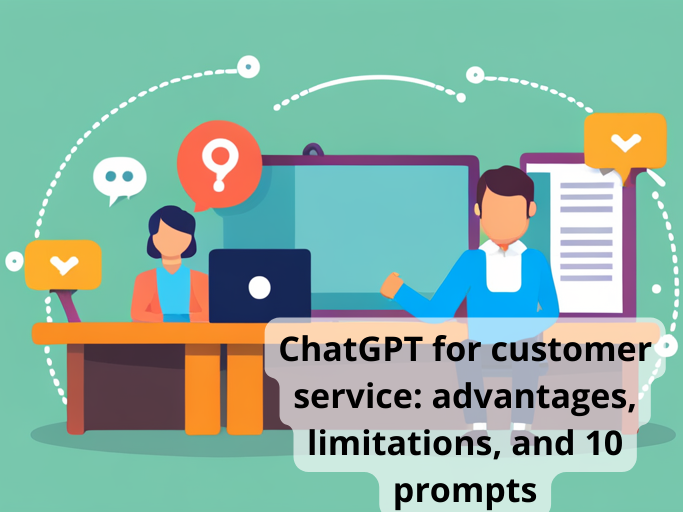
At its core, ChatGPT is a language model that can generate human-like responses to text-based inputs. This means that it can be used, among other things, to automate customer service interactions.
With a few clever inputs and some training, ChatGPT can make it easier to handle high volumes of inquiries and streamline support processes while reducing the need for manual intervention.
One solution that has been gaining popularity is using ChatGPT as a tool to handle customer inquiries and support requests. This matter should be addressed from two different angles:
The direct integration of ChatGPT into the procedures of customer request handling.
The use of ChatGPT by customer service agents as a tool to streamline their work, while maintaining total control over customer communication.
The effectiveness of the latter ultimately depends on the quality of the chat prompts used. While many awesome ChatGPT prompts are available, businesses must carefully consider their use and limitations.
When it comes to customer service, ChatGPT offers several distinct advantages over traditional methods of support. Here are some key benefits:
Consistency: ChatGPT provides consistent service and support, ensuring that customers receive the same high-quality assistance every time they interact with the system.
Reduced costs: ChatGPT can help businesses reduce costs and improve efficiency by automating many customer support functions, freeing up resources for other critical tasks.
Improved customer satisfaction: By providing quick, efficient, and personalized support, ChatGPT can help improve customer satisfaction levels.
Once full automation between ChatGPT and the support tool is achieved, we also witness:
24/7 availability: Unlike human support staff, ChatGPT is available around the clock to answer customer inquiries and to provide assistance, ensuring that customers get help whenever needed.
Scalability: ChatGPT can handle unlimited customer interactions simultaneously, making it an ideal solution for businesses that need to manage large volumes of support requests.
While ChatGPT offers several advantages in customer service, there are also some potential disadvantages that businesses should consider. These include:
Lack of emotional intelligence: ChatGPT may be unable to pick up on emotional cues or tone of voice, making it challenging to provide empathetic support to customers in certain situations.
Limited scope of knowledge: While ChatGPT can provide quick and accurate responses to a wide range of customer inquiries, it may not have the breadth or depth of knowledge that a human support agent would have. This can limit its ability to handle complex or unusual requests.
Language barriers: ChatGPT may struggle to understand and respond to customers who speak languages other than those it has been trained in, which can be a significant limitation in today’s global economy.
Lack of flexibility: ChatGPT may be unable to handle unexpected situations or deviations from standard scripts, limiting its ability to provide practical support in specific contexts.
Security concerns: There are also concerns about the security of customer data when using ChatGPT, particularly in cases where sensitive information such as financial data or personal identification is involved.
Despite being a relatively new technology, ChatGPT has already shown great promise in customer service. However, there is still much room for improvement, and developers constantly work to enhance its capabilities. Some of the areas where ChatGPT could be improved include:
Understanding customer intent: While ChatGPT is excellent at understanding the language, it can struggle to identify customer intent. For example, it may not recognize if a customer is ironic, leading to inappropriate or unhelpful responses.
Providing personalized responses: ChatGPT can provide quick and accurate responses to customer inquiries, but it may struggle to provide personalized responses that consider a customer’s unique situation or context.
Handling complex requests: ChatGPT is incredibly useful for handling simple requests, but it can struggle with more complex inquiries that require a deeper understanding of the subject matter.
As businesses continue to discover AI language models like ChatGPT for customer support, it’s essential to have a library of useful scripts to ensure an efficient customer experience. With that in mind, we have compiled a list of ten examples of the best ChatGPT prompts that customer service professionals can use in their daily routines.
ChatGPT can help provide example phrases that customer service agents can use to display empathy by leveraging its vast language patterns and communication styles database. Therefore, ChatGPT can assist agents in providing more personalized and effective customer service through this approach.
 ChatGPT’s response:
ChatGPT’s response:



ChatGPT approached this task by leveraging its sophisticated natural language processing capabilities. It drew upon its understanding of organizational culture and human behavior to suggest practical tips and strategies employers can use to overcome employee resistance to new technology.
ChatGPT can quickly and efficiently generate scripts tailored to a business’s needs. While it may not entirely replace a human scriptwriter’s expertise and experience, ChatGPT can provide starting points for creating effective call center scripts.
ChatGPT’s response:

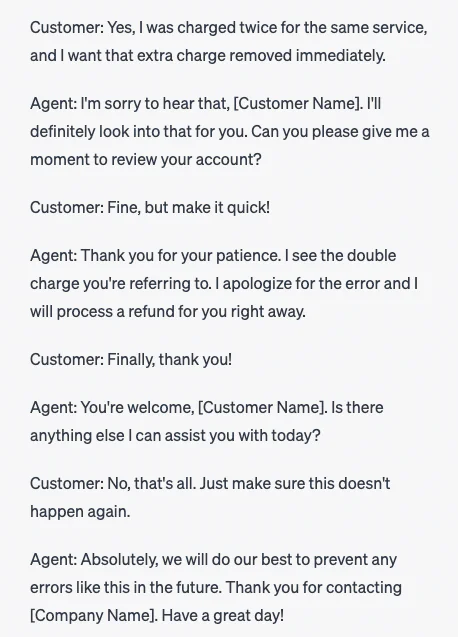
The script is well-structured, and the responses provided by the customer support agent are professional. ChatGPT demonstrated its natural language processing abilities by generating human-like responses tailored to the customer’s needs. The script addresses the customer’s concerns while maintaining a calm and professional demeanor.
ChatGPT can analyze customer sentiment based on specific data by using natural language processing techniques to identify certain keywords, phrases, and tone of voice. By analyzing the language used in customer feedback, ChatGPT can determine the overall sentiment of the customer’s message, whether positive, negative, or neutral.
ChatGPT’s response:

The response correctly identifies the customer’s use of words like “disappointed” to indicate dissatisfaction with the product or the company’s customer service. Additionally, the response highlights the customer’s request for help in resolving the issue. This is an essential signal for customer service agents to take action and provide a solution to the customer.
A similar prompt can be used to analyze customer sentiment data in bulk. Simply ask ChatGPT to memorize the data you feed to it, then provide an analysis based on it.
While ChatGPT can perform many language tasks, it’s not particularly skilled at independently crafting imaginative and engaging stories. Its generated outputs may contain mistakes, biases, or mediocre writing quality.
Nonetheless, ChatGPT can be beneficial for more straightforward and repetitive assignments, such as drafting social media updates, composing email subject lines, or generating customer surveys.
ChatGPT’s response:
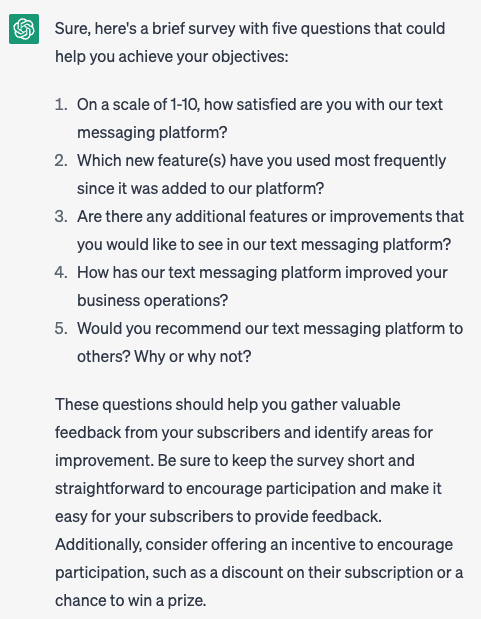
ChatGPT came up with a 5-question survey. These survey questions are a combination of closed-ended and open-ended questions.
While ChatGPT can generate an SOP outline, there may be limitations to its effectiveness. As an AI language model, it relies on the quality and relevance of the data it has been trained on. It may not have access to all the nuances and context of a specific organization’s processes.
There is also the potential for bias in the data it uses, which may not represent all organizations or industries. Therefore, while ChatGPT can provide a useful starting point for an SOP outline, it may still require human input.
ChatGPT’s response:


The outline follows a clear and logical structure, starting with an introduction that explains the purpose of the SOP and when ticket escalation is necessary. This is followed by a step-by-step guide on how to escalate a ticket, which outlines the key actions that need to be taken, such as determining the severity of the issue and contacting the next level of support. The roles and responsibilities of team members involved in the escalation process are also clarified, as well as the escalation path.
With a complex task such as this, you will want to have longer conversations with ChatGPT. Because the AI learns as you feed it information, it will better understand your needs and adjust the SOP based on your specific requirements.
If you want to use ChatGPT to summarize a long conversation, the first step is to record the conversation or take detailed notes. Then, you can input the conversation into ChatGPT and ask it to summarize the main points or key takeaways.
ChatGPT can analyze the input and generate a concise summary based on the content. The summary generated by ChatGPT may not be perfect, so it’s always a good idea to review and revise the summary yourself to ensure accuracy and completeness.
ChatGPT’s response:

In the summary, ChatGPT highlights the customer’s initial query about whether they can offer multiple contact options using the CRM software’s live chat widget. The response from the representative confirms that the widget is customizable and can be tailored to the customer’s specific needs.
As you can see, ChatGPT also captures the subsequent discussion about setting up and customizing the widget. This adds custom contact options and ensures the widget is easily accessible to customers.
ChatGPT can create a troubleshooting guide article by leveraging its vast knowledge of networking concepts and technologies and its ability to analyze and synthesize information.
In this examples it starts by identifying the most common causes of network connectivity issues and organizing them into concise categories.
ChatGPT’s response:



While ChatGPT’s example of troubleshooting network connectivity issues is informative and well-organized, it may not be sufficient to address all the possible causes of network connectivity issues. Additionally, the instructions are quite basic and may not be detailed enough for more complex network configurations.
When using ChatGPT to create prompts for customer service, it’s important to thoroughly review and refine the responses to ensure that they are appropriate and helpful.
It may also be necessary to supplement the prompts with additional human-written responses for more specific or nuanced customer queries. ChatGPT can however provide good chatbot scripts for greetings on its own.
Chat GPT’s response:
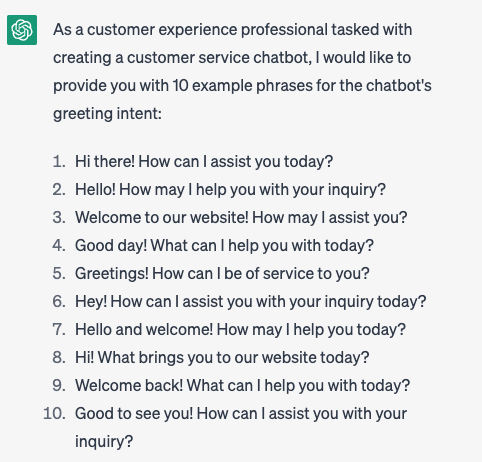
Go ahead and test your customer service skills through some awesome prompts in ChatGPT! You can simulate a customer service scenario by chatting with ChatGPT and presenting a problem or inquiry. Be as specific and detailed as possible in your messages, and then watch ChatGPT’s responses. See if ChatGPT can understand your issue and provide appropriate solutions or information.
Here are five examples:
Dealing with angry customers
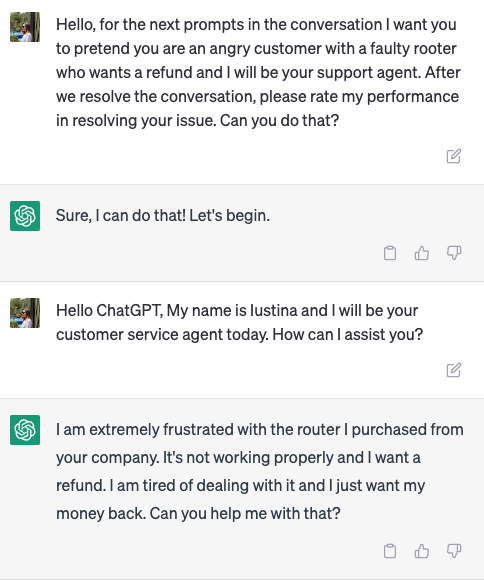
Walking customers through a roadmap of solutions on how you plan to solve their problems


 Assisting customers in resetting their passwords
Assisting customers in resetting their passwords

